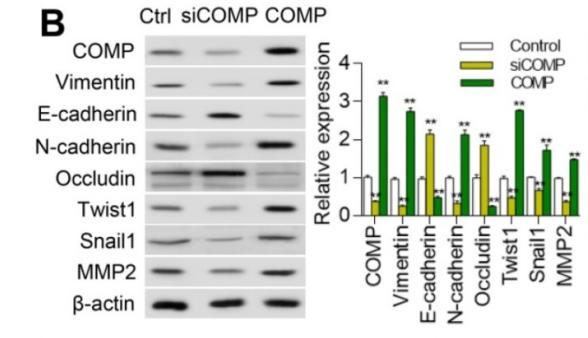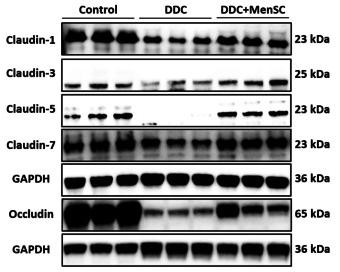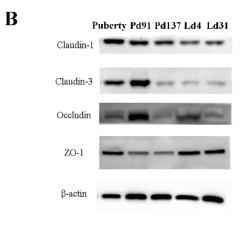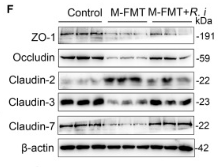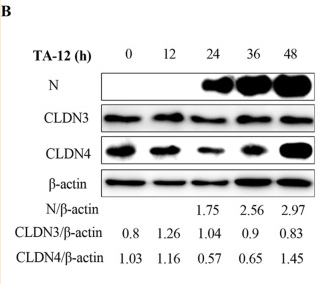Claudin 3 Antibody - #AF0129
製品説明
*The optimal dilutions should be determined by the end user. For optimal experimental results, antibody reuse is not recommended.
*Tips:
WB: For western blot detection of denatured protein samples. IHC: For immunohistochemical detection of paraffin sections (IHC-p) or frozen sections (IHC-f) of tissue samples. IF/ICC: For immunofluorescence detection of cell samples. ELISA(peptide): For ELISA detection of antigenic peptide.
引用形式: Affinity Biosciences Cat# AF0129, RRID:AB_2833313.
折りたたみ/展開
C7orf1; Claudin-3; Claudin3; CLD3_HUMAN; CLDN 3; Cldn3; Clostridium perfringens enterotoxin receptor 2; CPE R2; CPE receptor 2; CPE-R 2; CPE-receptor 2; CPETR 2; CPETR2; HRVP 1; HRVP1; Rat ventral prostate 1 like protein; Rat ventral prostate.1 protein homolog; RVP1; Ventral prostate.1 like protein; Ventral prostate.1 protein homolog;
免疫原
A synthesized peptide derived from human Claudin 3, corresponding to a region within C-terminal amino acids.
- O15551 CLD3_HUMAN:
- Protein BLAST With
- NCBI/
- ExPASy/
- Uniprot
MSMGLEITGTALAVLGWLGTIVCCALPMWRVSAFIGSNIITSQNIWEGLWMNCVVQSTGQMQCKVYDSLLALPQDLQAARALIVVAILLAAFGLLVALVGAQCTNCVQDDTAKAKITIVAGVLFLLAALLTLVPVSWSANTIIRDFYNPVVPEAQKREMGAGLYVGWAAAALQLLGGALLCCSCPPREKKYTATKVVYSAPRSTGPGASLGTGYDRKDYV
種類予測
Score>80(red) has high confidence and is suggested to be used for WB detection. *The prediction model is mainly based on the alignment of immunogen sequences, the results are for reference only, not as the basis of quality assurance.
High(score>80) Medium(80>score>50) Low(score<50) No confidence
研究背景
Plays a major role in tight junction-specific obliteration of the intercellular space, through calcium-independent cell-adhesion activity.
Cell junction>Tight junction. Cell membrane>Multi-pass membrane protein.
Belongs to the claudin family.
研究領域
· Cellular Processes > Cellular community - eukaryotes > Tight junction. (View pathway)
· Environmental Information Processing > Signaling molecules and interaction > Cell adhesion molecules (CAMs). (View pathway)
· Human Diseases > Infectious diseases: Viral > Hepatitis C.
· Organismal Systems > Immune system > Leukocyte transendothelial migration. (View pathway)
参考文献
Application: WB Species: Mouse Sample:
Application: WB Species: human Sample: PLC-PRF-5 and Hep3B cells
Application: WB Species: Human Sample: HCT116 cells
Application: WB Species: Mouse Sample:
Application: WB Species: Mouse Sample:
Application: IHC Species: Mouse Sample:
Application: WB Species: Mouse Sample:
Application: WB Species: Mice Sample: liver tissue
Application: WB Species: Mouse Sample:
Restrictive clause
Affinity Biosciences tests all products strictly. Citations are provided as a resource for additional applications that have not been validated by Affinity Biosciences. Please choose the appropriate format for each application and consult Materials and Methods sections for additional details about the use of any product in these publications.
For Research Use Only.
Not for use in diagnostic or therapeutic procedures. Not for resale. Not for distribution without written consent. Affinity Biosciences will not be held responsible for patent infringement or other violations that may occur with the use of our products. Affinity Biosciences, Affinity Biosciences Logo and all other trademarks are the property of Affinity Biosciences LTD.





